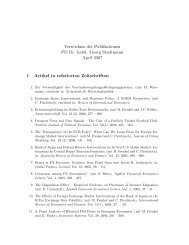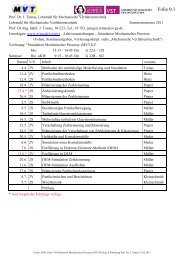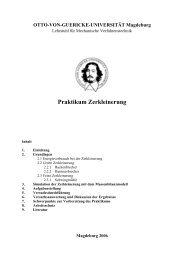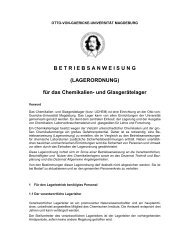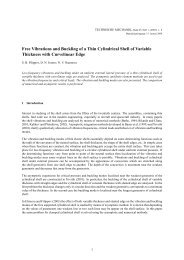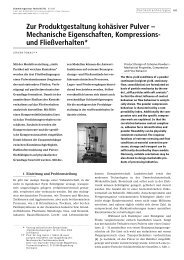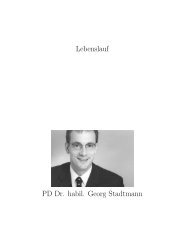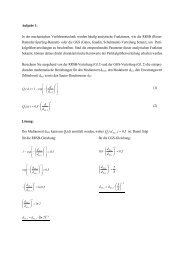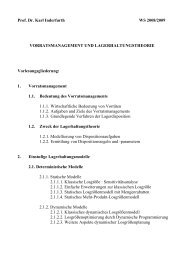20J. TomaspF = F + ⋅ F = F + ⋅ F(42)VdWκH H0 p N H0 p NfThe <strong>adhesion</strong> force F H0 without additional consolidation (F N = 0) can be <strong>approach</strong>edas a single rigid sphere–sphere contact (Fig. 1a). But, if this particlecontact is s<strong>of</strong>t enough the contact is flattened by an external normal force F N to aplate–plate contact (Fig. 2c). The coefficient κ p describes a dimensionless ratio <strong>of</strong>attractive van der Waals pressure p VdW for a plate–plate model, Eq. (19), to repulsiveparticle micro-hardness p f which is temperature sensitive:p Cκ (43)VdWH,slsp= =p 3f 6 ⋅ π ⋅ aF= 0 ⋅ pfThis is referred to here as a plastic repulsion coefficient. The Hamaker constantC H,sls for solid–liquid–solid interaction (index sls) according to Lifshitz’ theory[70] is related to continuous media which depends on their permittivities (dielectricconstants) and refractive indices [75]. The characteristic <strong>adhesion</strong> separationfor a direct contact is <strong>of</strong> a molecular scale (atomic center-to-center distance) andcan be estimated for a molecular force equilibrium (a = a F=0 ) or interaction potentialminimum [75, 76, 91]. Its magnitude is about a F=0 ≈ 0.3–0.4 nm. This separationdepends mainly on the properties <strong>of</strong> liquid-equivalent packed adsorbed waterlayers. This particle contact behavior is influenced by mobile adsorption layersdue to molecular rearrangement. The minimum separation a F=0 is assumed to beconstant during loading and unloading for technologically relevant powder pressuresσ < 100 kPa (Fig. 2c).For a very hard contact this plastic repulsion coefficient is infinitely small, i.e.,κ p ≈ 0, and for a s<strong>of</strong>t contact κ p → 1.If the contact circle radius r K is small compared to the particle diameter d, theelastic and plastic contact displacements can be combined and expressed with theannular elastic A el and circular plastic A pl contact area ratio [57]:pF F FVdWH=H0+ ⋅N2 A elpf⋅ 1+ ⋅ 3 Apl(44)For a perfect plastic contact displacement A el → 0 and one obtains again Eq.(42):F ≈ F + κ ⋅ F(45)H H0 p NThis linear enhancement <strong>of</strong> <strong>adhesion</strong> force F H with increasing preconsolidationforce F N , Eqs. (41), (42) and (45), was experimentally confirmedfor micrometer sized particles, e.g., by Schütz [94, 95] (κ p = 0.3 for limestone)and Newton [96] (κ p = 0.333 for poly(ethylene glycol), κ p = 0.076 for starch, κ p =
<strong>Mechanics</strong> <strong>of</strong> <strong>nanoparticle</strong> <strong>adhesion</strong> — A <strong>continuum</strong> <strong>approach</strong> 210.017 for lactose, κ p = 0.016 for CaCO 3 ) with centrifuge tests [92] as well as bySingh et al. [97] (κ p = 0.12 for poly(methylmethacrylate), κ p ≈ 0 for very hardsapphire, α-Al 2 O 3 ) with an Atomic Force Microscope (AFM). The two methodsare compared with rigid and rough glass spheres (d = 0.1–10 µm), without anycontact deformation, by H<strong>of</strong>fmann et al. [98]. Additionally, using the isostatictensile strength σ 0 determined by powder shear tests [91, 122, 147, 149, 151], this<strong>adhesion</strong> level is <strong>of</strong> the same order <strong>of</strong> magnitude as the average <strong>of</strong> centrifuge tests(see Spindler et al. [99]).The enhancement <strong>of</strong> <strong>adhesion</strong> force F H due to pre-consolidation was confirmedby Tabor [30], Maugis [85, 86] and Visser [110]. Also, Maugis and Pollock [58]found that separation was always brittle (index br) with a small initial slope <strong>of</strong>pull-<strong>of</strong>f force, dF N,Z,br /dF N (F N,Z,br ≈ – F H ), for a comparatively small surface energyσ ss <strong>of</strong> the rigid sphere–gold plate contact (index ss). In contrast, a pull-<strong>of</strong>fforce F N,Z,br proportional to FNwas obtained from the JKR theory [58] for thefull plastic range <strong>of</strong> high loading and brittle separation <strong>of</strong> the contact (Table 1):FF* NN,Z,br=−σss⋅E⋅3π ⋅ pf(46)Additionally, a load-dependent <strong>adhesion</strong> force was also experimentally confirmedin wet environment <strong>of</strong> the particle contact by Butt and co-workers [78, 79]and Higashitani and co-workers [87] with AFM measurements.The dominant plastic contact deformation <strong>of</strong> surface asperities during thechemical–mechanical polishing process <strong>of</strong> silicon wafers was also recognized,e.g., by Rimai and Busnaina [111] and Ahmadi and Xia [141]. These particlesurfacecontacts and, consequently, asperity stressing by simultaneous normalpressure and shearing, contact deformation, microcrack initiation and propagation,and micr<strong>of</strong>racture <strong>of</strong> brittle silicon asperity peaks affect directly the polishingperformance. Thus the Coulomb friction becomes dominant also in a wet environment.2.3. Variation in <strong>adhesion</strong> due to non-elastic contact consolidation2.3.1. Elastic–plastic force–displacement modelAll interparticle forces can be expressed in terms <strong>of</strong> a single potential functionFi =±∂Ui( hi)/∂hiand thus are superposed. This is valid only for a conservativesystem in which the work done by the force F i versus distance h i is not dissipatedas heat, but remains in the form <strong>of</strong> mechanical energy, simply in terms <strong>of</strong> irreversibledeformation, e.g., initiation <strong>of</strong> nanoscale distortions, dislocations or latticestacking faults. The overall potential function may be written as the sum <strong>of</strong>the potential energies <strong>of</strong> a single contact i and all particle pairs j. Minimizing thispotential function ∂U / ∂ h = 0 one obtains the potential-force balance.ij ijij



